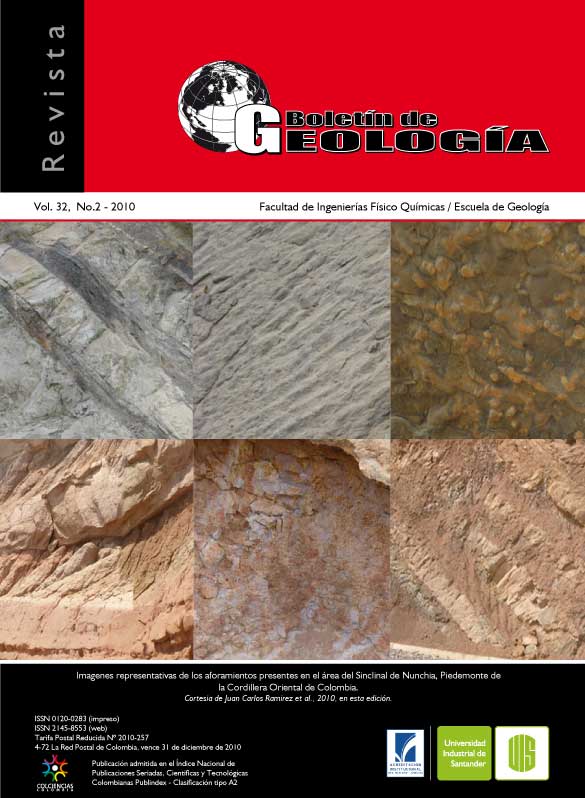ANÁLISIS CINEMÁTICO Y DEFORMATIVO DE LOS METAGABROS DEL RÍO OLIVARES SECTOR NNW DE MANIZALES (CALDAS)
Published 2011-08-08
How to Cite
Abstract
The Metagabbro of Rio Olivares (Toro et al., 2010), is a lithological unit located on the Río Olivares shore, NNWsector of the Manizales city. The primary minerals belonging to this unit are calcic plagioclase and clinopiroxene.This unit has ductile shear zones in which mylonites series are formed, brittle shear zones with development of rocks of the cataclasites series are superimposed to the previous one. In the mylonites there are pyroxene,and plagioclases porphyroclasts, with asimetrical tails that indicate dextral shear. Also, pseudotachylites veins are developed, that indicate paleo earthquakes. Plagioclases have microstructures of ductil deformation such asflexed twinned crystals, sweeping undulatory extinction, core–mantle structures and dynamic recrystalization by grain boundary migration. This mineral also has brittle microstructures such as microfractures, microfaultsand deformation twins. The clinopyroxenes show patches and sweeping undulatory extinction like ductilemicrostructures and microfractures as fragile microstructures. Mesoscopic and microscopic dextral movements and the shape of the shear zones indicate partitioning of the deformation. The above could be explained by adextral oblique collision of plates.
Key words: Manizales, metagabbros, deformation, pseudotachylites.
Downloads
References
Memoria explicativa. Ingeominas, Bogotá.He, C., Zhou, Y., and Sang, Z. 2002. An experimental study on semi-brittle and plastic rheology of Panzhihua gabbro. Science in China, 46(7).Kennan, L., and Pindell, J., 2009.
Dextral shear, terrene accretion and basin formation in the Northern Andes: best explained by interaction with a Pacific-derived Caribbean Plate. In: James, K., Lorente, M. A. & Pindell, J. (eds)
he geology and evolution of the region between North and South America. Geological Society of London. Special Publication. In press.Nivia, A., 1996. El Complejo Estructural Dagua, Registro de Deformación de la Provincia Litosférica Oceánica Cretácica Occidental en un Prisma Acrecionario: VII Cong. Col. Geol. Mem, 3, pp 54–67.Passchier, C. and Trouw, R., 2005. Microtectonics, Berlin, Springer Verlag, 289 p.Sibson, R.H., 1977.
Fault rocks and fault mechanisms. J. Geological Soc. London, Vol. 133(3): pp. 191–213.Snoke, A., Tullis, J. and Todd, V., 1998. Fault–related rocks. A photographic atlas.
Princeton, Princeton University Press. 427 p.
Toro, L. M., Hincapie, G. y Ossa, C., 2010. Petrografía y geoquímica de los metagabros del Río Olivares sector NNW de Manizales (Caldas). En esta edición.Vernon, R.H., and Clarke, G.L. 2008. Principles of metamorphic petrology. Ed. Cambrigde University Press. 446p.
